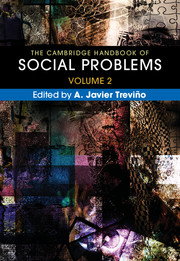Book contents
- The Cambridge Handbook of Social Problems
- The Cambridge Handbook of Social Problems
- Copyright page
- Contents
- About the Contributors
- Introduction
- Part I Problems Related to Health, Safety, and Security
- Part II Problems Related to Crime and Violence
- Chapter 12 The Problem of Crime
- Chapter 13 Corporate Malfeasance as a Social Problem
- Chapter 14 The Construction of School Bullying as a Social Problem
- Chapter 15 Rampage School Shootings
- Chapter 16 Understanding Sexual Violence: The Role of Causal and Precipitating Factors in Sexual Offending
- Chapter 17 Critical and Intersectional Understandings of Campus Sexual Assault as a Social Problem
- Chapter 18 Child Abuse and Neglect
- Chapter 19 Family Violence
- Chapter 20 Juvenile Violence
- Chapter 21 Gangs and Gang Violence
- Chapter 22 State Violence
- Chapter 23 Hate Crime
- Chapter 24 Police Brutality
- Chapter 25 Capital Punishment/Death Penalty
- Chapter 26 Wrongful Convictions: Comparative Perspectives
- Part III Problems of Global Impact
- Index
- References
Chapter 15 - Rampage School Shootings
from Part II - Problems Related to Crime and Violence
Published online by Cambridge University Press: 16 March 2018
- The Cambridge Handbook of Social Problems
- The Cambridge Handbook of Social Problems
- Copyright page
- Contents
- About the Contributors
- Introduction
- Part I Problems Related to Health, Safety, and Security
- Part II Problems Related to Crime and Violence
- Chapter 12 The Problem of Crime
- Chapter 13 Corporate Malfeasance as a Social Problem
- Chapter 14 The Construction of School Bullying as a Social Problem
- Chapter 15 Rampage School Shootings
- Chapter 16 Understanding Sexual Violence: The Role of Causal and Precipitating Factors in Sexual Offending
- Chapter 17 Critical and Intersectional Understandings of Campus Sexual Assault as a Social Problem
- Chapter 18 Child Abuse and Neglect
- Chapter 19 Family Violence
- Chapter 20 Juvenile Violence
- Chapter 21 Gangs and Gang Violence
- Chapter 22 State Violence
- Chapter 23 Hate Crime
- Chapter 24 Police Brutality
- Chapter 25 Capital Punishment/Death Penalty
- Chapter 26 Wrongful Convictions: Comparative Perspectives
- Part III Problems of Global Impact
- Index
- References
Summary
We introduce readers to the social problem of rampage school shootings and discuss the associated patterns, causes, and best practices for their prevention. While media coverage might suggest otherwise, rampage shootings at schools are extremely rare, even if they often yield much carnage and anxiety. At the individual level, some have focused on the mental illnesses or personality disorders of rampage killers. At the macro-sociological level, others have clarified the role that masculinity and widespread acceptance of gun culture play in reinforcing and legitimizing violence. Some scholars have recently attempted to achieve a more multifaceted, holistic, and cross-disciplinary understanding of the causes of school rampages. Moreover, the so-called copycat phenomenon is now recognized as a factor in a number of high-profile, high–body count murders. In order to avert future rampage attacks, schools must seek to forge genuinely positive school climates that encourage student bystanders to intervene in a responsible manner.
- Type
- Chapter
- Information
- The Cambridge Handbook of Social Problems , pp. 253 - 268Publisher: Cambridge University PressPrint publication year: 2018
References
- 4
- Cited by



